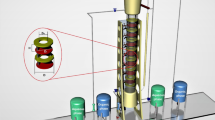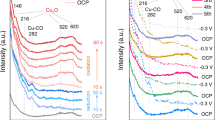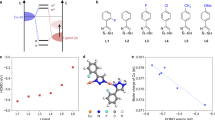Abstract
As an extension of our previous study on cellulose–cuprammonium system,1 an attempt was made to clarify the structure of cellulose–cuprammonium complex in the solid–liquid coexisting system by applying the fact that dissolution of cellulose into cuprammonium solution depends strongly on OH− concentration in the system. Electro-conductivity measurements on aqueous (aq) cuprammonium complex revealed that the complex existed as dissociated type at COH (OH concentration for aq solution) <0.3mol l−1 and as undissociated type at COH>0.5. Absorption reaction of aq cuprammonium complex on solid cellulose was also dependent on COH, revealing that the reaction order of OH− ion for the solid–liquid absorption reaction is unity and 0 for the system with COH less than 0.3 mol l−1 and for the system with COH>0.5 mol l−1, respectively. Meanwhile, the reaction order of copper to cellulose was found unity regardless the COH value. The latter fact might deny the random reaction of 3 OH groups in glucopyranose unit with copper ion and suggests indirectly the regio-selective complex formation of cuprammine and OH groups at C2 and C3 as previously proved. It was found that even if the molar ratio of copper ion in aq cuprammine complex to solid cellulose is more than unity, copper absorbed on solid cellulose is at most 0.65 mol mol−1. This value is quite near to that evaluated for the cellulose dissolved in cuprammonium solution. Using the above results a tentative new cellulose dissolving process is proposed, in which the less amount of copper and NH3 are employed, compared with those used for conventional process.
Similar content being viewed by others
Login or create a free account to read this content
Gain free access to this article, as well as selected content from this journal and more on nature.com
or
References
I. Miyamoto, M. Inamoto, T. Matsui, M. Saito, and K. Okajima, Polym. J., 27, 1113 (1995).
R. E. Reeves, Science, 99, 148 (1944).
K. Hess and E. Messmer, Ber., 54, 834 (1921).
K. Hess and E. Messmer, Ber., 55, 2432 (1922).
K. Hess and E. Messmer, Ann. Chem., 435, 1 (1923).
K. Hess and C. Trogus, Z. Phys. Chem.,A, 145, 401 (1929).
H. Sobue, Jinzosenigaku, 120 (1950).
W. Traube, Ber., 54, 3320 (1920).
S. M. Neale, J. Textile Inst., 16, T363 (1925).
Th. Liser and R. Ebert, Ann. Chem., 528, 276 (1937).
Th. Liser and R. Ebert, Ann. Chem., 534, 94 (1937).
K. H. Meyer, Hochpolymer Chemie, II, 274 (1940).
W. Brown and R. Wikström, Eur. Polym. J., 1, 1 (1966).
The Chemical Society of Japan, Ed., “Kagaku Binran Kisohen,” Vol. II, Maruzen Co., Tokyo, 1984, p 338.
Author information
Authors and Affiliations
Rights and permissions
About this article
Cite this article
Miyamoto, I., Matsuoka, Y., Matsui, T. et al. Studies on Structure of Cuprammonium Cellulose II. Structural Change of Cellulose–Cuprammonium Complex as a Function of Hydroxyl Ion Concentration. Polym J 27, 1123–1131 (1995). https://doi.org/10.1295/polymj.27.1123
Issue date:
DOI: https://doi.org/10.1295/polymj.27.1123



